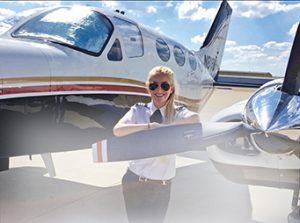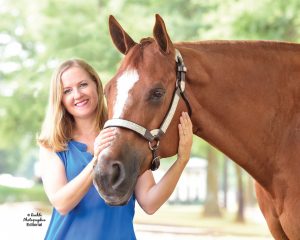Frequent Fliers – Tips for Equestrian Air Travel
Click here to read the complete article
74 – October 2019
 By Rachel Kooiker
By Rachel Kooiker
Your flight may or may not depart on time. Your baggage may or may not be pulled aside for some extra TSA attention due to the odd accessories stowed inside. You’ll likely have a hat or boot carrying case, instead of a carry-on, because there are just some things that can’t be trusted in the hands of others. The entire process may be frustrating, and you’ll have to constantly remind yourself that the horse show waiting on the other side of the plane ride is worth the hassle. If this sounds familiar, you’re an equestrian frequent flier, and we’ve got some great advice for you. Read on for tips and tricks on everything from finding the best prices on flights, to how far out you should book flights and anything else you might have wondered when thinking about horse-related travel.
Booking and Prices
It’s the week before you depart for the show. You’ve planned everything down to the last detail; but, somehow, you put off booking your flight until today. You pull up Google and start checking for flights, but where do you start? Expedia? Is Priceline still a thing? What in the world is Kayak? The choices for booking are seemingly endless. Beckie Peskin is a familiar face who can often be seen at many of the top AQHA circuits and shows. She’s also a bona fide frequent flier who logs serious sky miles for both work- and horse-related travel. She sums up her airtime by saying, “I’m a fairly frequent flyer both for work and horse fun. I’m usually on a plane two times a month at least, mostly for work, but I also sprinkle in some horse and family trips, too.”
Kathy Avolt, owner of An Equine Production, manages not only her busy travel schedule but also the demands of sending out show management teams to different locations. Avolt shares, “Our travel needs vary per show and location. You learn to pack as tightly as you can. You know what 50 pounds feel like, and we carry a scale for just such purposes.” When it comes to booking and pricing, Avolt isn’t just looking after her bottom line, she’s often pricing with a club’s budget in mind, as well. She explains, “We try to be very conscientious of booking travel to take advantage of sales, discounts, and special pricing. It saves the club/affiliate that we work for a few dollars here and there if we’re careful that way.”
While some of us are mindful of the important dates on our calendars for showing, it’s important to step back and examine whether or not your equine travel might coincide with other peak travel times. Avolt says, “Some flights are booked several months ahead if we book at peak travel times.” If you’ve ever wondered if there is a  magic pricing window when airfares are magically reduced, you can put that notion to rest. Peskin remarks, “There are surely days and times that can get you better deals, but you then have to consider other expenses that can be incurred if you go in a day early or stay a day late. I’m not much on booking using the flexible days’ option, because I’m usually trying not to be gone more than I need to be. I happen to love flying in the late evening and always try to catch the red-eye home from my west coast trips. I’m also a solid airplane sleeper, so that helps.”
magic pricing window when airfares are magically reduced, you can put that notion to rest. Peskin remarks, “There are surely days and times that can get you better deals, but you then have to consider other expenses that can be incurred if you go in a day early or stay a day late. I’m not much on booking using the flexible days’ option, because I’m usually trying not to be gone more than I need to be. I happen to love flying in the late evening and always try to catch the red-eye home from my west coast trips. I’m also a solid airplane sleeper, so that helps.”
Favorite Airlines and Rewards Programs
Peskin says that as far as airline choices go, she’s a Delta girl. “If they are high, I will fly Southwest or American,” she says. As far as the worst airline, Peskin laughs and says, “Under no circumstances will I fly Spirit!” She adds, “Delta often lowers fares early, so if something seems high, I will often wait until Tuesday afternoon to see if it moves.” As far as timing your booking for the best price, that can depend on your ability to plan weeks in advance and the flexibility you require. Peskin shares, “I try to stick with three to four weeks out; but with balancing a family, a career, and the horses, that sometimes means that booking has to be tighter to my travel time.”
Avolt concurs saying, “Always book directly with the airline. If you have an issue, a third party such as Expedia will not be helpful.” However, on airlines, Avolt recommends, “We try to travel with Southwest Airlines as much as possible. First, the bags are free. It saves the club/affiliate money. Second, if we have to change a flight, there’s not an expensive change fee. Now, keep in mind, that if you have status on an airline (diamond, platinum, etc.) the change fee is free or minimal. Third, if we have to cancel a flight, we can easily wrap that fare to a future flight.”
Joining a rewards program is usually worth it, and Peskin says, “I generally have status with Delta. As far as booking, I go directly to Delta for personal travel. Work travel is usually booked through the company’s third-party site. Delta and their Sky Miles program is my favorite; but, since I live in the Atlanta area, that’s an easy choice. I love their app, their site, and their planes, etc.” Avolt imparts, “If you travel regularly, you should belong to every airline program, every hotel program, every car rental, etc. Why not earn points, miles, etc.? The programs are free and easy to sign up for.”
The (Strange) Things We Carry
Managing your “equine” baggage is never a certain thing. Any avid equestrian knows that there are certain things you can’t show without, like your hat, boots, and spurs. The nature of equestrian travel also means that sometimes your must-show items are coming with you on a plane. So, how do you ensure that important items don’t get left behind? Peskin says, “If I’m really worried about an item making it with me, I will carry it on the plane. I have been a bit of a horse show nomad over the past three to four years as my last horse was home a good bit, but I would still meet up with my trainer at the big shows. If I can make it happen, I try to send my clothes and important stuff with someone driving. If I can’t, then I say a little prayer! Since I have been doing that for the past few years, it’s essential to have good checklists, and I try to consolidate where I can. But, that’s tough to do when I show in at least six events at most shows.”
Security Hacks
You’ve purchased your ticket, and you’ve made it to the airport. It’s now time for the real obstacle of airline travel: security. Peskin laughs and says, “No spurs! Those will really confuse them. I splurged on CLEAR since ATL and several of the airports I frequent have the service.” CLEAR is a paid service that uses biometrics to make your travel through security checkpoints faster and more efficient. Peskin continues, “I don’t mind taking out my computer and taking off my shoes. CLEAR has saved my butt several times at several airports because you get through so fast! I love it. Even the Monday after the Super Bowl in Atlanta, when the airport was a mess, I didn’t wait more than 15-20 minutes to get through security checkpoints.”
Avolt warns, “Do not get behind me in the pre-check lane! We travel with a lot of electronics. Even with TSA Pre-Check, you must remove multiple items. I often wonder what TSA thinks when they open a suitcase and there is 300 feet of network cable tightly wound up on Christmas light-spools, or when they open a tote and there are laser printers.” Pre-check is something that many equestrians travelers may want to look into. TSA PreCheck is a U.S. government program that allows travelers deemed low risk by the Transportation Security Administration (TSA) to pass through an expedited security screening at certain U.S. airports. To receive TSA Pre✓, you must include your known traveler number in the appropriate field of your airline reservation, and the TSA Pre✓ indicator must be visible on your boarding pass and embedded in the barcode. There is an application fee for PreCheck.
 Boots, Hats, and Spurs?
Boots, Hats, and Spurs?
Can you carry on spurs? The official answer from most airlines is yes, however, it may be worth calling the airline you’re booking with to double-check. Keep in mind that security procedures are subject to frequent change. The officials are likely going to make the best decision they can concerning the safety of all passengers. That said, exhibitors have had many different experiences traveling with spurs, hats, and more that are worth noting.
Chandra Hildebrand, APHA Amateur and self-described professional “fly-in” client: “My trainer, Blake Carney, told me that he’s never had trouble traveling with boots and spurs. He just tucks the spurs into his boots. I tried that once, and I was flagged and my whole carry-on had to be inspected. The TSA people had obviously never seen spurs before! So, if you do, I recommend placing them where they can be easily extracted. My experience was very difficult.”
Alexis Solakian, APHA Amateur: “I travel with spurs a ton. I’ve asked TSA before, and they said spurs are approved. I did have a few TSA agents sit around and scratch their heads over what they could be for when they saw on them in my carry-on in the x-ray. They finally concluded that they were cow spurs and that they couldn’t be used as a weapon because they can’t be sharp enough to hurt the cow! I thought about correcting them, but I figured if they were going to let me through then I might as well not risk it.”
Katy Jo Zuidema, horse trainer: “I travel with spurs in my carry-on all the time. I put them in my boots at the bottom of my suitcase and then put everything else on top of it. I feel like if they’re with cowboy boots there is less explanation needed. I’m not sure if that matters, but it seems to work.”
Lori Arthur, IHSA Coach: “The best advice I’ve ever received was to ship your equine items directly to the show. We pack a box with a hat can, chaps, spurs, show shirt, etc. and send it ahead via UPS. Then, we call ahead to the hotel and let them know to expect a large box, which they were great about holding for us. After the show, you just pack it back up and take it to the UPS store and send it home!”
Rachel Sackrider, AQHA Amateur: “I pack my show clothes separately in a carry-on rolling garment bag and try not to let that leave my side, if at all possible. I carry a small purse, and then I count my hat can as my personal item. I usually check my spurs, but they can go in a carry-on, and I usually let TSA know they’re in there before it goes through the scanner. Last month, on my way to Nebraska for the 2019 AQHA West Level 1 Championships, I had a short connecting flight and had to run to get to my flight, and none of my bags made it. I will now pack some necessities with me in my backpack in case I have to go a day without my luggage.”
Fly By Horror Stories
What happened when the worst happens? We asked our equestrians to tell us about their flying horror stories.
“We were flying home from Florida this year for spring break out of a tiny airport. We boarded, and the airplane had a mechanical issue, so we pulled back in,” Peskin says. “The airport was so small there were only two places to eat. One had no food and the other had only snacks and alcohol. We were flying over dinner time and, luckily, we had a big lunch. Long story short, we ended up stranded there for five hours. We couldn’t even order Uber Eats, because they closed security right after we all came through, so if you went out, you were locked out. Delta did a terrible job of managing this problem. For example, they ordered pizzas, but there wasn’t enough to feed everyone. It was all good, though. We snacked, had a couple of drinks, and watched the Final Four NCAA March Madness. There were several other kids on the flight, so my daughter thought it was the most amazing five-hour playdate ever. In all, it was a long day, but we made it.”
Avolt doesn’t have a specific flying horror story to share, but instead wisely reminds us, “We all complain, moan and whine, but unless you can fly private, you must deal with weather issues and mechanical issues. In an ideal world, it’s a perfect 70 degrees when the flight goes off. But, if you’re coming from or going to a cold climate during the winter months, be prepared for issues involving Mother Nature. She can be your best friend or your worst enemy, and there is nothing you can do about it.”
Before Takeoff
As a parting shot before takeoff, here are a few additional words of wisdom to pack along for the ride.
Peskin: “Just be prepared. Have on hand power cords, snacks, or even cash to buy those things if you have to. My favorite thing to do to pass the time is to people watch. Airports can truly bring out the worst, and sometimes the best, in humanity. I amuse myself by calling out both and may or may not post my findings on Facebook… I find that a little laugh always makes bad actors more bearable.”
Avolt: “Patience, patience, and patience. Maybe bring a good book and a Starbucks.”
From the Cockpit: Professional Advice
The Equine Chronicle also reached out to the professional pilot and long-time equestrian, Paige Stawicki, for some advice from the pilot’s perspective on equestrian flying. Read on for her insights:
“I’m currently a pilot at American Eagle based in New York. I live in the city with my fiancé, Blake, who is also a pilot. On average, I fly four to five days a week covering most of the northeast and some Canadian destinations. Unfortunately, very little of my current travel is horse-related. I grew up showing on the APHA circuit as a youth and later rode for the University of Georgia’s equestrian team. Since graduating, my sole focus has been to get to my end goal, career-wise, before starting to show again. I hope to one day get back into the horses and travel all over for that again, but it will probably be a couple more years before I will be able to do that.”
Booking Advice
“As an airline member, I fly for free, providing there is space available on the plane. I’ll usually keep an eye on a specific flight for about a week, and then 24 hours before departure, I list myself for the flight. Again, I only get on if there is an extra seat, but because of this policy, and my ability to sit in the jumpseat in the cockpit if there are no seats in the cabin, I very rarely book revenue flights anymore. When I do book flights, I always start with an app called Last Minute. That app shows all airline options and prices for the route you’re wanting to fly. After I have narrowed down the times, connections, and airlines I would be interested in flying, I’ll go to their specific site to see if I can find the exact flight cheaper. Usually, the Last Minute app is the lowest price, but if you want points or rewards and the cost to book with the airline is almost the same, sometimes that’s the better option overall.”
Best Time to Fly and Delay Details
“For the New York area, morning flights and weekend flights are usually more successful than others. I can’t speak for the rest of the country, but the New York airspace is greatly affected when any weather is in the area. Because of the number of high volume airports in such close proximity (Newark, Kennedy, LaGuardia, and Teterboro), the New York controllers are very quick to issue flight EDCTs (expected departure clearance times) or delays. This is basically their way of saying that there is no more room in the airspace for any more planes, so they need you to sit on the ground for a bit before allowing you to head their way until the airspace clears up. This can be extremely frustrating for passengers, especially when the weather radar looks pretty benign; but, we, as pilots, have absolutely no control over these times. These delays are not airplane, airline, or origination airport specific. Because of all of this, I would definitely suggest starting your travels earlier in the day before the afternoon storms start brewing.”
Favorite Airline
“I’m partial toward American Airlines because my mom, Beverly Bass, worked for them, and I grew up flying them all over the world; but honestly, they’re all pretty good. I’m not too familiar with all the reward programs out there, but I would say flying the major airline that has a base at your home airport is always the safest bet.”
Baggage
“Always keep important items with you in a carry-on. If you absolutely cannot imagine parting with something forever, do not check it! I’ve never had a bag lost, but it can happen very easily, especially with close connection times. If you do check, I would suggest putting something on your bag that makes it stand out like a scarf tied around the handle, neon tape, or bright luggage tags. So many bags look alike. Make sure no one will mistake yours for their own. Also, I would suggest leaving a business card or address card inside your suitcase. So many tags fall off during the loading/offloading process. Make sure someone can track you down if your outer tags get ripped off at some point.”
Security Tips
“Definitely get PreCheck if possible. You can do this by signing up for Global Entry. After that, you will need to ensure that your Known Traveler Number is included in your online profile for that airline to ensure you get it on every flight. If you have Global Entry but realize you get a boarding pass without TSA PreCheck, go to the ticket counter with your Global Entry card and they will give you a new boarding pass.”










